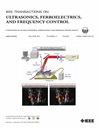用于细胞生物学的单束声镊:从分子到体内水平
IF 3
2区 工程技术
Q1 ACOUSTICS
IEEE transactions on ultrasonics, ferroelectrics, and frequency control
Pub Date : 2024-09-09
DOI:10.1109/TUFFC.2024.3456083
引用次数: 0
摘要
声镊在细胞生物学的各个领域都备受关注,包括体外单细胞和细胞间力学。与光学镊子和磁性镊子等其他镊子技术相比,声学镊子具有更强的力,在生物系统中使用更安全。然而,由于空间分辨率有限或目标物体大小有限,声镊主要用于体外操作细胞。为了将声学镊子的优势扩展到其他层面(如分子和体内层面),研究人员最近开发了各种类型的声学镊子,如单束声学镊子(SBAT)、表面声波镊子和声流镊子。其中,SBAT 利用单聚焦声束,与其他类型的镊子相比,它使传感器和系统变得简单、无创,并能产生强大的力。根据声束模式的不同,SBAT 可分为瑞利模式、米氏模式和声漩涡模式,其捕获动力学和应用水平也各不相同。在这篇综述中,我们概述了每种 SBAT 的原理和配置、从分子到体内研究的应用,以及它们的局限性和前景。因此,本综述展示了 SBAT 技术在生物物理学和生物医学工程中的意义和潜力。本文章由计算机程序翻译,如有差异,请以英文原文为准。
Single-Beam Acoustic Tweezers for Cell Biology: Molecular to In Vivo Level
Acoustic tweezers have attracted attention in various fields of cell biology, including in vitro single-cell and intercellular mechanics. Compared with other tweezing technologies such as optical and magnetic tweezers, acoustic tweezers possess stronger forces and are safer for use in biological systems. However, due to the limited spatial resolution or limited size of target objects, acoustic tweezers have primarily been used to manipulate cells in vitro. To extend the advantages of acoustic tweezers to other levels (e.g., molecular and in vivo levels), researchers have recently developed various types of acoustic tweezers such as single-beam acoustic tweezers (SBATs), surface acoustic wave (SAW) tweezers, and acoustic-streaming tweezers. Among these, SBATs utilize a single-focused beam, making the transducer and system simple, noninvasive, and capable of producing strong forces compared with other types of tweezers. Depending on the acoustic beam pattern, SBATs can be classified into Rayleigh regime, Mie regime, and acoustic vortex with different trapping dynamics and application levels. In this review, we provide an overview of the principles and configuration of each type of SBAT, their applications ranging from molecular to in vivo studies, and their limitations and prospects. Thus, this review demonstrates the significance and potential of SBAT technology in biophysics and biomedical engineering.
求助全文
通过发布文献求助,成功后即可免费获取论文全文。
去求助
来源期刊
CiteScore
7.70
自引率
16.70%
发文量
583
审稿时长
4.5 months
期刊介绍:
IEEE Transactions on Ultrasonics, Ferroelectrics and Frequency Control includes the theory, technology, materials, and applications relating to: (1) the generation, transmission, and detection of ultrasonic waves and related phenomena; (2) medical ultrasound, including hyperthermia, bioeffects, tissue characterization and imaging; (3) ferroelectric, piezoelectric, and piezomagnetic materials, including crystals, polycrystalline solids, films, polymers, and composites; (4) frequency control, timing and time distribution, including crystal oscillators and other means of classical frequency control, and atomic, molecular and laser frequency control standards. Areas of interest range from fundamental studies to the design and/or applications of devices and systems.

 求助内容:
求助内容: 应助结果提醒方式:
应助结果提醒方式:


